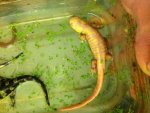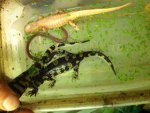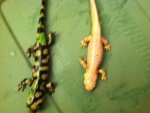I didn't pay the full price but still way more than I have ever paid for a Salamander. I have seen albinos presented every couple of years or so as well, however, it is rare for people to offer them for sale. Are my chances of being successful unlikely? I feel like I have a solid chance. Since my plans center on the viability of this one salamander, there is a good chance that you are right, however, if this salamander is viable I feel relatively confident that I can meet the triggers necessary to stimulate breeding behavior. From my research I have gathered the following:
1. Overwintering a must
2. breeding pool at least 6 inches deep, 14 inches or more preferable, with branches leaves, silt bottom, still water.
3. Changes in lighting
4. Changes in humidity
5. Changes in Temperature, with between 54 and 56 degrees being optimal breeding temps.
From what I have read in the wild, the males head to breeding pools triggered by temperature, humidity, changes in lighting en-mass, the females follow about week later with the additional trigger of male pheromones.
I should be able to simulate most of that pretty easily. The pheromones thing is probably the trickiest part, though I am not sure it is required. I have some ideas for it that I may try, like getting a large group of males that will not be in the breeding group but in the pool prior to adding the breeding group. Another idea is making a pheromone disperser, which would involve soaking males and dispersing that water with a wick and small fan. I guess it would be fun to try and isolate and synthesize the pheromone but that would probably take some serious time to accomplish, still I would not take it off the table. If there is something I am missing let me know. As for the demand for albino salamanders, I am not really doing it for the money, just for love of the animal. For me the purpose of captive breeding is two fold, first is education, there is no better way to learn the needs and requirements of a species than to keep it and breed it successfully, and two, to reduce the demand for wild caught specimens which is best achieved through breeding color morphs. Locality breeding only encourages more collecting. Morph breeding competes with this. If I am successful with this project my next one will be to introduce the GFP gene, but I am getting way ahead of myself now.



